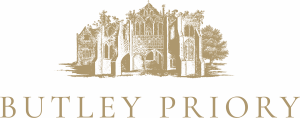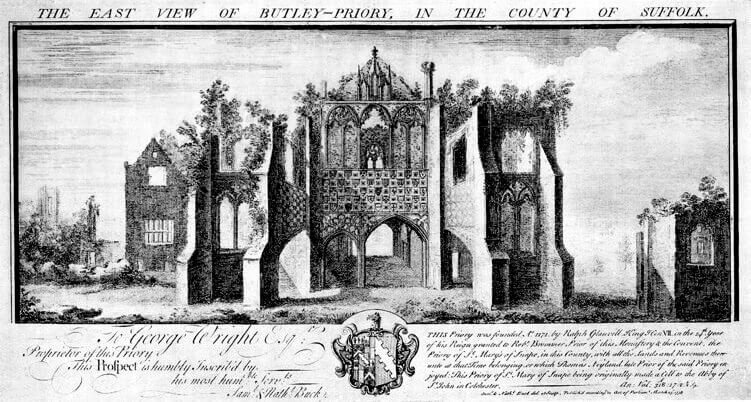History of Butley Priory
Butley Priory is the only building that remains intact of the Augustinian Priory founded here in 1171. It was built under William de Greystone, Prior from 1311 to 1322, so is now 700 years old.
The Priory originally comprised a magnificent collection of buildings and covered an area of twenty acres, enclosed by a stone wall. Although little remains of this once great Priory, except for this fine Gatehouse and an arch that once led out of the south transept of the church, the plan of the site is known from the excavations carried out by Dr Montague Rendall, scholar and ex-Headmaster of Winchester College, who bought the Gatehouse in 1926.
‘Adorned with a unique display of contemporary heraldry’ - Country Life Magazine, published 25th March 1933
Unique features of the Priory Gatehouse are its exuberant flint flushwork decoration and the extensive armorial on the north side. This is “an amazing fantasy, wonderfully preserved, though its complete charm can only be fully realised from a scaffold or by means of a powerful glass, so delicate is its carving and expression of little sprightly features that adorn it, so rich the imagination with which they are inspired.” The coats of arms in the armorial range from the great powers of Europe of the day… the Papacy, the Holy Roman Empire and the crowns of England and France … through grandees of England and on down to local squires.
The stone used to build the Priory was brought by barge from the valley of the Yonne in France, across the English Channel, and up the Butley Creek estuary to a wharf only 200 yards south of the Priory.
It would seem from early records that the most important person after the Sub-Prior, and possibly the most popular, was the cellarer. In the only two instances where the records tell us of the position previously held by the newly elected prior, we are told that he had been the cellarer … William de Greystone in 1311 and Thomas Sudbourne in 1528.
Tradition has it that somewhere in the Priory grounds is buried a silver coffin containing the body of the third earl of Suffolk, who fell at the side of Edward duke of York at the Battle of Agincourt in 1415.
The first king to visit the Priory was Henry lll, who arrived on March 9th 1235. Then during the time of Prior Augustine Rivet (1509-28), the Priory became the regular resort of royalty and nobility who came there for the hunting. Mary Tudor, sister of Henry Vlll, was particularly fond of it and visited often, including a visit of two months with her new husband, Charles Brandon, Duke of Suffolk, in 1527.
On August 6th that year, as it was very hot, Mary Tudor ordered their supper to be laid out in a shady part of the garden on the east side of the gatehouse. This she so enjoyed that alfresco suppers became a regular feature of her stays at Butley. It is also recorded that in Brother Nicholas’s garden the royal party were overtaken by a violent thunderstorm, and had to rush to the church for shelter.
On March 1st 1538, the Priory and all its lands were surrendered to Henry Vlll. The Commissioner who received the surrender, William Petre, stated that ‘We have today received the surrender of Butley, to which the Convent assented very quietly.’
For the next two years, the Priory was used as a hunting lodge before being granted to Thomas, Duke of Norfolk, who in turn sold it to William Forthe of Hadleigh in 1544 for £944 2s 2d. Anne, his only daughter, inherited it and later married Viscount Hereford, who left it to his daughter Elizabeth who married John Clyatt in 1684.
In 1737, George Wright Esq married the Clyatt heiress and inherited the property. It was George Wright who restored the Gatehouse and converted it into a ‘handsome mansion’. Later the house became the residence and shooting seat of many prominent people of the day, including the Marquis of Donegall, Lord Archibald Hamilton and Lord Rendlesham. It then went into decline for some years and was used only as an occasional, and very cold, vicarage. Finally, in 1926, it was saved again by the aforementioned Dr ‘Monty’ Rendall, who called in the famous architect Caroe and began an intensive programme of restoration of the Priory to a country house.
A new front entrance was introduced into an angle of the east wing, bedrooms and a bathroom were put on the first floor up 48 stairs, and a kitchen created. Buttresses were repaired and the armorial frieze carefully conserved.
It appears that such was Dr Rendall’s passion for the building that he spent his last penny on the restoration work. He sold the Priory to his neighbour Sir Bernard Greenwell who let him live there to the end of his life, and whose descendants now own it.
Due to its unique appeal, the house has featured in design and interior decorating magazines as well as national newspapers on several occasions. One cannot help but wonder what the monks would have made of it…





